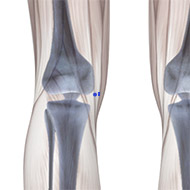Rated Acupoints
Acupuncture Treatment For Hernia
BACK TO THE TOP
Hernia is a condition where an internal body organ push down through the weakness of the muscle or surrounding tissue wall. There are some type of hernia, which are inguinal hernia, richter’s hernia, femoral hernia, umbilical hernia, and hiatal hernia. Hernia usually happen between your chest and hips. This invasion of body organ can produce lump or swelling in your abdomen. This lump can often be pushed back in or disappear when the patien lie down. Coughing or straining can make the lump reappear. This type of hernia is called as inguinal hernia.
1
CONTENTS
SYMPTOMS
CAUSES
TREATMENTS
SYMPTOMS
The most common symptom of hernia, especially for inguinal hernia is the present of the lump at your abdomen. The other symptoms of hernia would be burning or sharp pain sensation, tearing sensation, feeling of fullness, fever, nausea, and vomiting.
2
CAUSES
The main caused of hernia is a combination of muscle weakness and strain. Hernia can develop suddenly or gradually over a long period of time. The cause of the muscle weakness are congenital defect, age, chronic coughing, surgery, being pregnant, heavy weight lifting, fluid in the abdomen, and sudden weight gain.
3
TREATMENTS
Related Acupuncture Points :
St-30/ Liv-8/ Liv-3
Acupuncture Treatment For Hernia
Acupuncture treatment practise regard the disorder of hernia is caused by immunity weakness, qi of kidney deficiency. The treatment generally will aim to raise the yang, or the qi of the spleen. The treatment will take a place at some acupoints including KI27 (shu fu), ST13 (qi hu), GV20 (bai hui) and LR5 (li gou), and some group of acupoints known as naganos. The explanation of the use of acupoints are as follow :
1. KI27 : It is the last point of the kidney meridian. It is regarded as the shu of shu points. KI27 is
located two cun lateral to the ren channel, on the lower border of the clavicle.
2. ST13 : This point is located close to KI27. It is found four cun lateral to the ren channel on the
lower border of the clavicle. ST13 is a site of intersection of the stomach, large intestine, triple warmer, small intestine, and many other divergent meridians, hence its ability to raise the yang.
3. GV20 : It is the most well known point for the treatment of hernia. It is located five cun within
the anterior hairline on the governing vessel channel, it has the ability to raise the yang, especially with the use of moxibustion.
4. LR5 : It is an additional point to use to treat the hernia, especially if the disorder is related to
liver, as in the case of inguinal hernia or uterine prolapse.
5. Naganos : It is a special group of points that can be needled in the treatment of hernia. It is
located at the close proximity to LI11 (qu chi) and LI10 (shou san li).
BACK TO THE TOP
Footnotes
- Hernia, NHS Choices, http://www.nhs.uk/Conditions/hernia/Pages/Introduction.aspx
- Hernia, Written by Carmella Wint and Valencia Higuera, http://www.healthline.com/health/hernia#Causes3
- Hernia (Abdominal Hernia), Medical Author: Benjamin Wedro, MD, FACEP, FAAEM, http://www.medicinenet.com/hernia_overview/page2.htm#what_causes_an_abdominal_hernia
- Prolapse: A Natural Condition with Oriental Medicine, By Skya Abbate, DOM, http://www.acupuncturetoday.com/mpacms/at/article.php?id=27766
LU01
LU02
LU03
LU04
LU05
LU06
LU07
LU08
LU09
LU10
LU11
LI01
LI02
LI03
LI04
LI05
LI06
LI07
LI08
LI09
LI10
LI11
LI12
LI13
LI14
LI15
LI16
LI17
LI18
LI19
LI20
ST01
ST02
ST03
ST04
ST05
ST06
ST07
ST08
ST09
ST10
ST11
ST12
ST13
ST14
ST15
ST16
ST17
ST18
ST19
ST20
ST21
ST22
ST23
ST24
ST25
ST26
ST27
ST28
ST29
ST30
ST31
ST32
ST33
ST34
ST35
ST36
ST37
ST38
ST39
ST40
ST41
ST42
ST43
ST44
ST45
SP01
SP02
SP03
SP04
SP05
SP06
SP07
SP08
SP09
SP10
SP11
SP12
SP13
SP14
SP15
SP16
SP17
SP18
SP19
SP20
SP21
HT01
HT02
HT03
HT04
HT05
HT06
HT07
HT08
HT09
SI01
SI02
SI03
SI04
SI05
SI06
SI07
SI08
SI09
SI10
SI11
SI12
SI13
SI14
SI15
SI16
SI17
SI18
SI19
BL01
BL02
BL03
BL04
BL05
BL06
BL07
BL08
BL09
BL10
BL11
BL12
BL13
BL14
BL15
BL16
BL17
BL18
BL19
BL20
BL21
BL22
BL23
BL24
BL25
BL26
BL27
BL28
BL29
BL30
BL31
BL32
BL33
BL34
BL35
BL36
BL37
BL38
BL39
BL40
BL41
BL42
BL43
BL44
BL45
BL46
BL47
BL48
BL49
BL50
BL51
BL52
BL53
BL54
BL55
BL56
BL57
BL58
BL59
BL60
BL61
BL62
BL63
BL64
BL65
BL66
BL67
KD01
KD02
KD03
KD04
KD05
KD06
KD07
KD08
KD09
KD10
KD11
KD12
KD13
KD14
KD15
KD16
KD17
KD18
KD19
KD20
KD21
KD22
KD23
KD24
KD25
KD26
KD27
PC01
PC02
PC03
PC04
PC05
PC06
PC07
PC08
PC09
TB01
TB02
TB03
TB04
TB05
TB06
TB07
TB08
TB09
TB10
TB11
TB12
TB13
TB14
TB15
TB16
TB17
TB18
TB19
TB20
TB21
TB22
TB23
GB01
GB02
GB03
GB04
GB05
GB06
GB07
GB08
GB09
GB10
GB11
GB12
GB13
GB14
GB15
GB16
GB17
GB18
GB19
GB20
GB21
GB22
GB23
GB24
GB25
GB26
GB27
GB28
GB29
GB30
GB31
GB32
GB33
GB34
GB35
GB36
GB37
GB38
GB39
GB40
GB41
GB42
GB43
GB44
LV01
LV02
LV03
LV04
LV05
LV06
LV07
LV08
LV09
LV10
LV11
LV12
LV13
LV14
GV01
GV02
GV03
GV04
GV05
GV06
GV07
GV08
GV09
GV10
GV11
GV12
GV13
GV14
GV15
GV16
GV17
GV18
GV19
GV20
GV21
GV22
GV23
GV24
GV25
GV26
GV27
GV28
CV01
CV02
CV03
CV04
CV05
CV06
CV07
CV08
CV09
CV10
CV11
CV12
CV13
CV14
CV15
CV16
CV17
CV18
CV19
CV20
CV21
CV22
CV23
CV24




